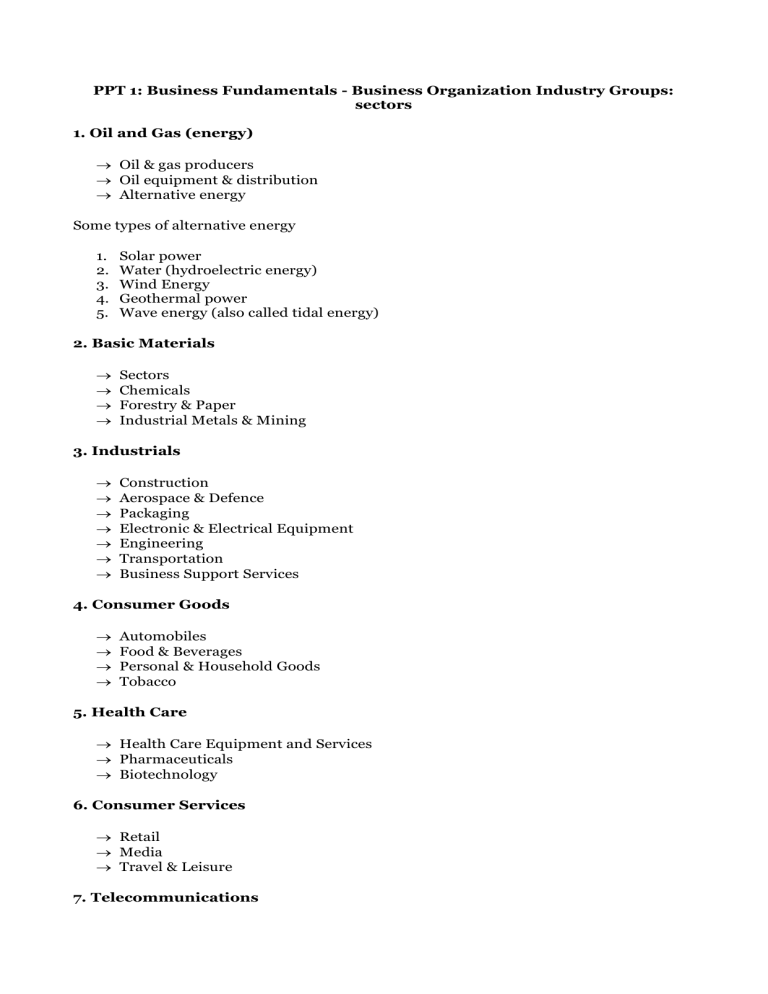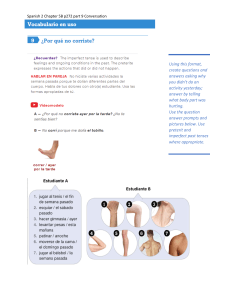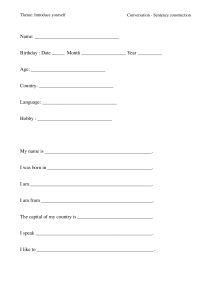Business Fundamentals: Industry, Organization, Economics
advertisement

PPT 1: Business Fundamentals - Business Organization Industry Groups: sectors 1. Oil and Gas (energy) Oil & gas producers Oil equipment & distribution Alternative energy Some types of alternative energy 1. 2. 3. 4. 5. Solar power Water (hydroelectric energy) Wind Energy Geothermal power Wave energy (also called tidal energy) 2. Basic Materials Sectors Chemicals Forestry & Paper Industrial Metals & Mining 3. Industrials Construction Aerospace & Defence Packaging Electronic & Electrical Equipment Engineering Transportation Business Support Services 4. Consumer Goods Automobiles Food & Beverages Personal & Household Goods Tobacco 5. Health Care Health Care Equipment and Services Pharmaceuticals Biotechnology 6. Consumer Services Retail Media Travel & Leisure 7. Telecommunications Fixed and mobile telecommunications 8. Utilities Electricity Gas Water 9. Financials Banks Insurance Real Estate Equities (company shares that can be bought and sold on a stock market) 10. Technology Software Hardware Computer services PPT 2: Business fundamentals - Business organization Type of business: 1. Sole trader/sole proprietorship = the business is owned by one person who is responsible for any debts. 2. Partnership = two or more people run the business together. All partners share profits and losses. 3. Limited company/limited liability Company (ltd.) = the company is responsible for any losses, not the owners. The company is private, i.e. shares cannot be sold to the public. 4. Public limited company/Corporation (plc/corp)(inc) = the company is owned by shareholders who receive dividends and who may gain or lose money if the share price goes up or down. Business model: B2B = business to business B2C = business to consumer C2C = consumer to consumer B2B2C = business to business to consumer Management structure: The board = chairman, ceo, cfo, non-executive directors. Ceo= chief executive officer Cfo= chief financial officer The management committee: Top management = ceo, cfo, directors of marketing, hr, it… Hr = human resources It = information technology Middle management = managers of divisions, departments, branches… Supervisory/ first line management = supervisors, team leaders PPT 3: Business Grammar builder Why use a diagram? 1. You can see the ‘big picture’ 2. You can see there is a pattern and logic to English verbs 3. You get a visual picture, this can help to understand and learn Past Present Future Past simple I started this job three years ago. Present simple I usually leave around 7:30. Will future I’ll be forty next year. Inflation will probably rise in the long term. Past continuous While I was working at ABC I moved from Sales to Marketing. Present continuous We’re developing two new products at the moment. Future continuous I’ll be working at our Paris office next year. Past perfect The merger had already happened when I joined the company. Present perfect I’ve been in this job for three years. I’ve finished the report Future perfect By the end of the year I expect that sales will have improved. Past perfect continuous We’d been selling the same product for years before we changed the design. Present perfect continuous I’ve been writing this report all morning. Future perfect continuous If I retire when I’m sixty, I’ll have been working here for more than twenty years. Was going to Sorry, I was going to call you but I completely forgot. Be going to future I’m going to ask my boss for a pay rise. First Row: 3 simple tenses Past simple: completed action/situation Present simple: actions/situations that are usually/always true (facts, habits, etc.) Future simple or will future: future facts or general beliefs Second Row: 3 continuous tenses All 3 continuous tenses have the meaning of an action in progress. There is also an associated meaning of action with a limited duration or temporary situation Third Row: 3 perfect tenses All 3 perfect tenses have the meaning of looking back. The past perfect looks back from the past. The present perfect looks back from the present. The future perfect looks back from the future. Notice the two examples for the present perfect: I’ve been in this job for three years. Shows time from the past until now I’ve finished the report. Shows the present result of a past action. In both cases, the meaning of “looking back from the present” is retained. Fourth Row: 3 perfect continuous tenses All have the meaning of looking back at an action in progress Note from the diagram how this is a combination of the meanings of the two previous lines: ‘looking back’ + ‘action in progress’. Fifth row: use of be going to Has a meaning of “Looking forward” Was/were going to looks forward from the past (an action which didn’t happen; if it did just use the past simple) Am/are/is going to look forward from the present Past to show social distance Knowing about the use of the past tense to show social distance can help to understand why: I was wondering if I could….? is more formal than Can I….? Past to show distant probability Knowing that we can use the past to show distant probability helps to understand why: If I could, I would is imaginary If I can, I will is a real possibility PPT 4: Business Fundamentals - Economic cycles The Business Cycle Economic growth usually follows a pattern of contraction and expansion, punctuated by troughs and peaks Trough = period when something that rises and falls regularly is at a low level, especially economic activity Peak = the time when something is at its highest or greatest level. RECESSION Recession a period when trade and industry are not successful and there is a lot of unemployment. When an economy is in recession, central banks lower interest rates to encourage spending. Business cycle • After reaching Market bottom = stock markets invest in technology and industrial sectors • Bull market begins well before recovery is visible in the economy • Bull market = a situation in the stock market when share prices are rising. • Bear market = a situation in the stock market when share prices are falling The stock market reaches market top before full recovery in the economy, Investors move into staples and services Growth increases, inflation increases, central banks raise interest rates in order to control inflation. Staple: an important product, especially a food, that people eat or use regularly. • • • • The markets then expect a period of contraction and become bearish • Investors prefer to invest in utilities and bonds • Economic growth starts to slow, • the economy moves into recession • The cycle continues Bond: a document given to someone who invests money in a government or company, promising to pay back the money with interest. The 4 Phases of the Investment Cycle: 1. ACCUMULATION: After the market has bottomed innovators and early adopters begin to buy at attractive prices in a market which is still bearish. 2. MARK-UP: In the mark-up phase, the fear of the majority of investors of losing money becomes weaker than the desire to make a profit and investors become first bullish, then excited, and finally even euphoric. 3. DISTRIBUTION: Value investors begin to sell; Prices remain high for some time; Greater fool investors continue to buy, hoping for further rises; Eventually prices drop and sellers settle for a breakeven or a small loss. Investors: Value investor: an investor who buys stocks they believe the market has undervalued. Greater fool investor: an investor who buys at a high price believing there will always be someone they can sell to at an even higher price. 4. MARK-DOWN: Most painful; When the market has plunged 50% or more many investors first panic, then give in. PPT 5: Breakeven Analysis BREAKEVEN POINT “The point at which a business operation no longer loses money and can begin to make a profit.” CAPITOLO 1 INCOMPANY: BUSINESS OR PLEASURE The importance of networking. Networking the action or process of interacting with others to exchange information and develop professional or social contacts. Small talks polite conversation about unimportant or uncontroversial matters, especially as engaged in on social occasions. So, how are you enjoying…? Isn’t this weather…? Where are you from originally… what’s it like? Am I right in thinking you…? Ah, I see. So …? Oh, that’s interesting, because I… Really? That’s a coincidence! So, tell me more about… Well, it’s been nice talking to you. Come portare avanti delle small talks: Use what you already know about people to start up a conversation. I hear you speak Cantonese, is that right? I understand you work for 3M. Try to bring people into conversation with others you know. Let’s see what Max thinks. Max, we’ve got a question for you. Kenichi, there’s someone I’d like you to meet. Show enthusiasm; pay people you know well the occasional compliment. You’re looking well. Been on holiday? Congratulations on the promotion, by the way! Be careful not to contradict people too directly. Well, that’s not entirely true, but I know what you mean. Actually, it’s not as bad as you might think. Start the subject smoothly by referring to what others have said. Funny you should say that, something very similar happened to me. On the subject of the merger, have you heard the latest? Don’t break off the conversation too abruptly at the end. Well, it’s been really nice talking to you. I’m afraid I’ll have to be going. But let me give you my card. Alcuni modi per dire no indirettamente: Not very, really, especially, exactly Not yet, anymore, at the moment Not as far as I know Actually, … As a matter of fact, … Paying and receiving compliments: You’re looking well! Great to see you again… I like your…. Where did you get it? You did a great job in the meeting/presentation the other day Compliments on your brilliant project design! You really know how to captivate an audience So a way to introduce a change of topic. Altri modi per cambiare l’oggetto della conversazione: Incidentally, … Talking of … By the way, … Before I forget, … That reminds me, … On the subject of … CAPITOLO 2 INCOMPANY: INFORMATION EXCHANGE Mindset, a way of thinking about things Core competencies, a skill or type of knowledge that makes an organization especially good at doing some things and gives it an advantage over other organizations Paradigm shift, a basic change in ideas or methods To think outside the box, to find new ways of doing things, especially of solving problems The bottom line, the most basic fact or issue in a situation Benchmark, to provide a standard that something can be judged by Empowerment, having more control over your life or more power to do something Come presentare un meeting: I’ve been asked to inform you that… It seems/appears that… I’m afraid that… It’s felt that… The following options are being explored… The suggestion is that… The basic idea is to… In addition, what’s being proposed is… This would obviously mean… Debating issues: I agree with you up to a point. That’s beside the point. Okay, point taken. That’s out of the question. It’s not a question of that. It’s also a question of … We’re not in a position to … This puts us in a very difficult position. I’m in no position to … The fact remains that … As a matter of fact, … In actual fact, … In view of the fact that … That’s not an option. Another option would be … There’s no time. CAPITOLO 3 INCOMPANY: RAPPORT Tips for building rapport: 1. The basics. Make eye contact, smile and be sincere; be sensitive to cultural differences, respect personal space, make small talks 2. The appearance. Try to look like the other person; your hair, clothes, make-up, nails, jewellery, beard or tattoos send messages about you and your values 3. The empathy. Use your emotional intelligence to create empathy. Developing an awareness of how feelings and emotions influence attitude and behavior will allow you to accentuate similarities and reduce differences 4. The connection. Take time to find a common ground. Finding a connection with the other person brings you closer and helps build trust 5. The mirroring. Matching and mirroring the other person’s speech, behavior and thought processes is something that comes naturally. Adapt your body language and speech with the person you’re dealing with Management Scenario A: Culture clash Presentations: CAPITOLO 4 INCOMPANY: VOICE AND VISUALS The attention span of the average audience member is 15 minutes People in audience are distracted every 12 seconds People prefer lower voices What people see overrides what they hear Presentations with visuals are 43% more persuasive Images are mentally processed 400.000 times faster than text Images and speech are processed by the opposite side of the brain Visual Presentations: 1. Introduction: Have a look at this. As you can see… 2. Highlights: o One thing you’ll immediately notice is that… o I’d particularly like to draw your attention to… o I’d also like to point out… o And perhaps I should mention… 3. Context: o Just to give you some of the background to this… o To put this into some kind of perspective… 4. Conclusions: o Clearly then, what these figures show is… o The lesson we can learn from this is… Voice Presentations: a pause is more then a way to vary your speaking rate: It is an important way to add emphasis and meaning to selected phrases and sentences It allows an audience a moment to think about an idea It indicates a shift to a new idea or to a new section of the speech, or to heighten anticipation of your next idea The presenter can sound fluent and confident, fluent but boring, hesitant CAPITOLO 5 INCOMPANY: PROBLEMS ON THE PHONE How to get rid of chatterboxes on the phone. We are living the age pf telephony, over 70% of population uses a mobile phone. We can get in touch whenever we want. Up to two hours in every working day are wasted in small talk on the phone, great skill and determination are needed to escape the conversation. Professional courtesy forbids to end a conversation in a brutal way like “I haven’t got all day”, even though this is what you really want to say. There are some ways to end a conversation in a polite way: 1. Getting down to business. We can bring the conversation round to the subject of the business asking, “What can I do for you?” or “I expect you’re calling about…” and mention something. In this way they will reply with the reason they called, and you can cut the conversation and get down of business. If this fails, you can also ask “Was there something you wanted to talk to me about?” 2. Ending the conversation. The secret is not to seem too abrupt ending the conversation with “Anyway…”. We can try instead “I mustn’t keep you”, “I’ll let you go on”, “I’ll have to let you go now”. There are also friendly alternatives like “We must get together soon”, “One last thing then I really must go”. 3. Drastic measures. In genuine emergencies you can try with “Someone just stepped into my office, I’ll have to ring off”, “I’ve got an international call just come in on the other line”. If it doesn’t work, you can pretend not to hear the other person anymore. Dealing with complaints: How to handle a customer complaint in an appropriate way: 1. Greet and reassure the caller. “How can I help you?” “What can I do for you?” 2. Get the details. “Can you tell me exactly what the problem is?” “What seems to be the problem?” 3. Listen and empathize. “I can understand exactly how you feel” “I can understand how upset you must be.” 4. Suggest possible solutions. “I can’t give you a refund, I’m afraid, but I certainly send you a new one. How’s that?” “Unfortunately, we’re not authorized to give refunds, but what can I do is send you a brand new one. How would that be?” 5. Agree on a course of action. “Is that all okay with you?” “Are you happy with that?” 6. End on a positive note. “I’m so pleased we’ve managed to sort this out. Was there anything else?” “Glad to be of assistance. Is there anything else I can help you with?”




